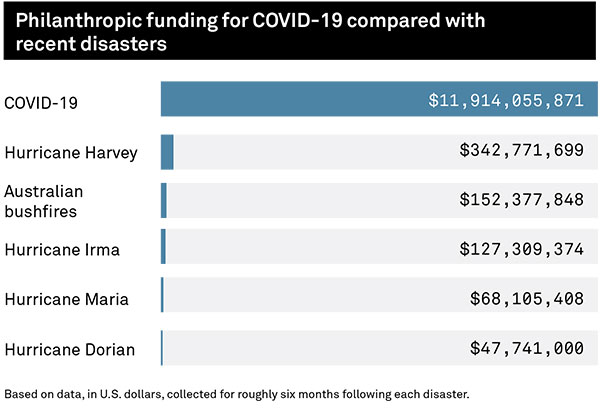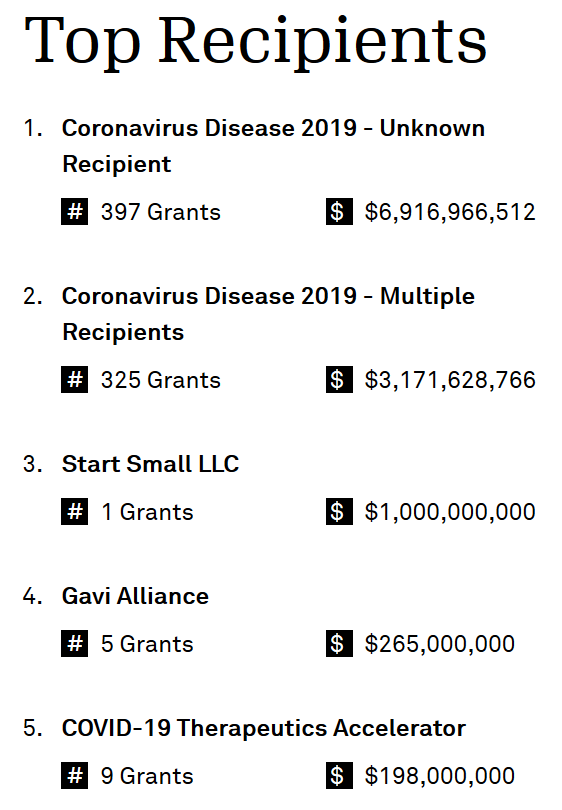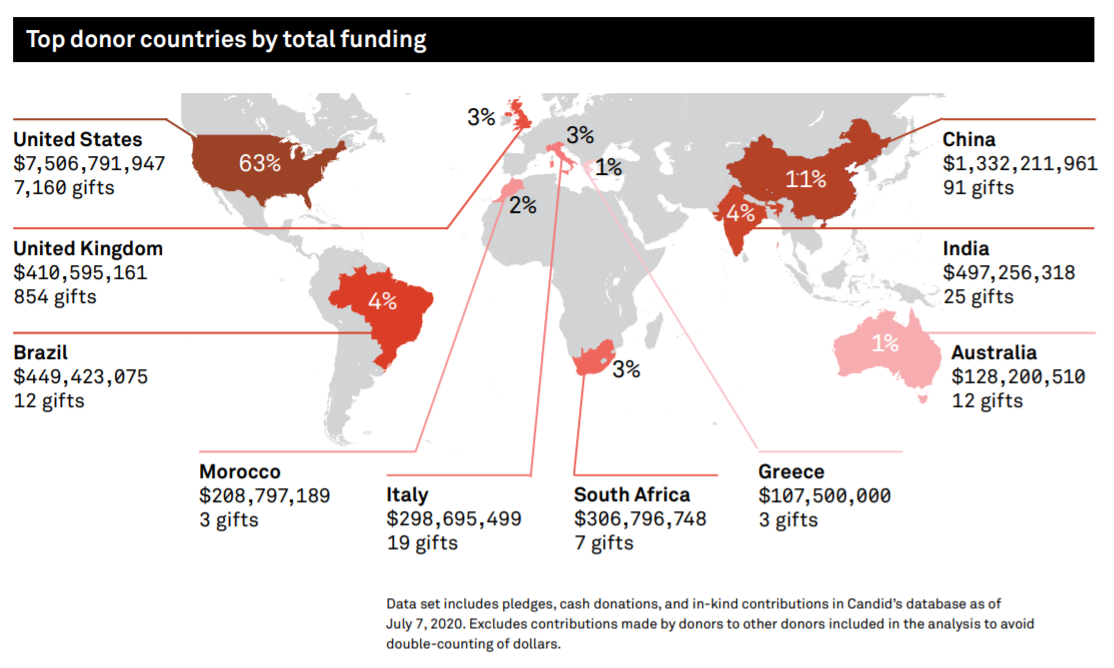What we don’t know about COVID-19 funding, and how you can help

Candid began tracking philanthropic gifts for COVID-19 funding on February 3, 2020—two weeks after the Centers for Disease Control confirmed the first U.S. case and as evidence of the pandemic’s disastrous scale was mounting. Recently, in partnership with the Center for Disaster Philanthropy, we documented $11.9 billion in global philanthropy for COVID-19 funding in the first half of the year. Coronavirus giving has continued, and, to date, Candid has identified roughly $14 billion.
Funding for the pandemic is larger than anything we’ve seen since we began collecting real-time data about disasters and humanitarian crises. And yet we know that there’s more global COVID-19 philanthropy we haven’t captured.

Why does it matter?
We hope that sharing real-time data about where funding is going will allow funders to put their grantmaking in context, coordinate their responses with others, and ensure impacted communities are not inadvertently left behind. This information also helps those who are doing crucial work on the ground understand what other efforts are underway and identify potential partners for their work. We display the data on our free, public coronavirus page and disaster philanthropy map.
How does Candid collect COVID-19 data?
We gather real-time data from publicly available, primarily English-language sources, including news articles, press releases, websites, and membership reports. Our technology scans roughly 300,000 news articles every day, identifying grants and donations made by funders and high-net-worth individuals. In addition, Candid receives data directly from funders who report details about their grantmaking to us. It’s a massive data collection and processing effort, involving dozens of colleagues who search, code, load, and create and improve systems for processing and displaying information on tens of thousands of COVID-19 grants/commitments and the individuals and organizations involved.
Candid already had processes in place to collect this information, honed over years of gathering data about disasters and humanitarian crises in partnership with the Center for Disaster Philanthropy. Because of the unprecedented scale and impact of the global pandemic, we made COVID-19 an organizational priority and dedicated considerably more staff than usual to collecting and processing as much data about coronavirus funding as possible. Although we ramped up our efforts, we know there is much we are missing.
What we don’t know
We don’t know which organizations have received the vast majority of funding captured by our tracking efforts. The two largest recipients of coronavirus funding in Candid’s database are “Unknown Recipient” and “Multiple Recipients.” We simply lack enough information to be more specific. In some cases, funders announced multiple recipient organizations but didn’t disclose how much funding was allocated to each. In others, funders announced pledges, or plans to spend a certain amount on their coronavirus response, but haven’t yet shared how they’ve begun to spend those resources. In our analysis of funding in the first half of 2020, we were unable to identify a recipient for 85 percent of dollars granted or pledged by grantmaking institutions.

We don’t know who has received payouts from special coronavirus funds. Candid has identified more than 945 COVID-19 response funds. These funds were created by community foundations, United Ways, and grantmaking entities in the U.S. and beyond. But our current data doesn’t reflect the hundreds of millions of dollars disbursed by these funds. Some grantmakers have yet to share information publicly about their disbursements. Some have listed recipient organizations without grant amounts or shared only aggregated totals. Unfortunately, this isn’t enough detail for Candid to include in our database and analysis.
Other organizations have begun transparently sharing their grantmaking on their respective websites with enough detail about the recipient organization, funding amount, and purpose for us to add that data to our database. (We see—and thank!—you, Smart Small LLC, All Together ATX Fund, and Innovia Foundation.) It is, admittedly, a challenge for us to actively search for this information on hundreds of organizations’ websites and why we invite funders to share their grantmaking data directly with us. When an organization posts grant details on its website, it communicates this important information to a specific audience, but sharing data with Candid communicates that information with the entire sector.
We don’t know who is benefiting from these funds. In our report, even when we excluded awards to unknown or multiple recipients, the analysis demonstrated that little institutional funding targeted Black, Indigenous, and people of color (BIPOC) communities. Among funders (excluding individual donors), only 5 percent of total dollars and 12 percent of awards explicitly identified BIPOC communities or BIPOC-serving recipient organizations—despite these populations being disproportionately affected by COVID-19. Three percent of dollars were explicitly designated for women and girls, and only 1 percent of funding was explicitly designated for people with disabilities.
One reason for this may be that the source from which we collected the data didn’t identify information about the intended beneficiaries. When an award is described as a “coronavirus response grant,” Candid does not assume a specific population focus—other than what’s identified in our taxonomy as “victims of disaster.” (For more on Candid’s population-specific coding, especially in relation to racial equity, please see this related blog post.) To overcome this limitation, Candid and CDP also took into account what we know about the recipient organizations and their missions. For example, a general support COVID-19 grant to the Center for Black Women’s Wellness or 100 Black Men of America was included as funding explicitly designated for BIPOC communities. Still, the numbers remained low.
It may also be that, in the first half of the year, the largest COVID-19 donations were not targeted to vulnerable communities. The Bill & Melinda Gates Foundation awarded hundreds of millions of dollars to advance COVID-19 treatments and vaccine development—critical, life-saving research needed to end the pandemic. This funding will, ideally, lead to benefits for vulnerable communities, but we can’t describe these grants as explicitly targeted to benefit them. And, as mentioned above, we can’t identify the recipients of 85 percent of the grants we’ve identified.
We don’t know as much about non-U.S. funding as we’d like. In our report, the global funding picture included donors in 38 countries and special administrative regions (including Hong Kong and Macao) to recipient organizations located in 52 countries, but we know we’re only scratching the surface.

Candid looks at news sources from around the world, but as a U.S.-based organization, we have the most access to data about the work of organizations in this country. Candid is building partnerships with organizations like Philanthropy Australia and Philanthropy Indonesia to build a global database of philanthropy. And to the extent that the information is in a form we can use, we’re also attempting to gather COVID-19 data collected via national and regional efforts around the world (such as 360Giving in the United Kingdom).
How you can help improve the data
If you’re with a foundation, community foundation, donor-advised fund, or other type of funder, there are several steps you can take.
Share information on your grantmaking with us. The Center for Disaster Philanthropy and Candid will be taking a second look at COVID-19 funding at the end of the year to see if there have been any changes in funding patterns since the first half of the year. To be meaningfully included in our analysis, you need only give us basic details about grants made: the recipient’s name, the recipient’s location (city and state/province), grant amount, and ideally, a grant description. Please be sure to include either the term “coronavirus” or “COVID-19” in your grant description.
Provide a detailed grant description describing the population group(s) you intend to reach. In general, a good grant description answers the questions WHAT, HOW, WHO, and WHERE. Our template for sharing grants data also provides space for you to explicitly specify population served. Funders know their work best; the more details you provide, the more accurately we can code and represent that work in our products and analysis.
Specify if you’re making a grant for general operating support. Nearly 800 foundations signed a pledge to provide flexible support for grantees during this time—including loosening or eliminating restrictions on current grants and making new grants as unrestricted as possible. So how much of COVID-19 funding is unrestricted (i.e., general support)? It’s a reasonable question but one that we’re not able to fully answer with the data we have. For one, Candid doesn’t have grantmaking data for many of the institutions that made this commitment. Also, the data we have may not explicitly be described as general support. Similar to the way we code grants for population groups, we don’t assume that a grant is for general operating support unless the funder identifies it as such.
If you know of a resource that would give us insight into non-U.S. COVID-19 funding, tell us. You can email us at [email protected].
Transparency and information sharing matter, especially in a crisis
Having better information means organizations don’t have to make important decisions about where their resources are needed most in a vacuum, and that the sum of their efforts can add up to more than the parts. Dealing with the health, economic, and social consequences of this pandemic will require that every dollar spent has maximum impact. As a funder, the time you take to share information about your work makes a difference. Learn more about how you can contribute to the global database of philanthropy for COVID-19.






